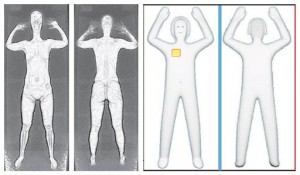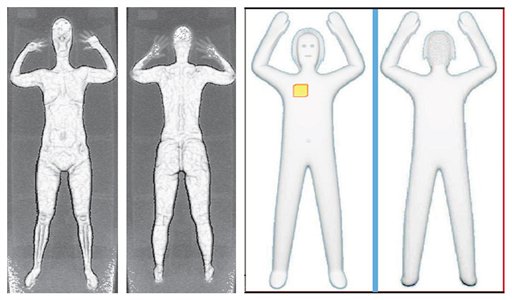
Associated Press
Those airport scanners with their all-too revealing body images will soon be going away.
The Transportation Security Administration says the scanners that used a low-dose X-ray will be gone by June because the company that makes them can’t fix the privacy issues. The other airport body scanners, which produce a generic outline instead of a naked image, are staying.
The government rapidly stepped up its use of body scanners after a man snuck explosives onto a flight bound for Detroit on Christmas day in 2009.
At first, both types of scanners showed travelers naked. The idea was that security workers could spot both metallic objects like guns as well as non-metallic items such as plastic explosives. The scanners also showed every other detail of the passenger’s body, too.
The TSA defended the scanners, saying the images couldn’t be stored and were seen only by a security worker who didn’t interact with the passenger. But the scans still raised privacy concerns. Congress ordered that the scanners either produce a more generic image or be removed by June.
On Thursday Rapiscan, the maker of the X-ray, or backscatter, scanner, acknowledged that it wouldn’t be able to meet the June deadline. The TSA said Friday that it ended its contract for the software with Rapiscan.
The agency’s statement also said the remaining scanners will move travelers through more quickly, meaning faster lanes at the airport. Those scanners, made by L-3 Communications, used millimeter waves to make an image. The company was able to come up with software that no longer produced a naked image of a traveler’s body.
The TSA will remove all 174 backscatter scanners from the 30 airports they’re used in now. Another 76 are in storage. It has 669 of the millimeter wave machines it is keeping, plus options for 60 more, TSA spokesman David Castelveter said.
Not all of the machines will be replaced. Castelveter said that some airports that now have backscatter scanners will go back to having metal detectors. That’s what most airports used before scanners were introduced.
The Rapiscan scanners have been on their way out for months, in slow motion.
The government hadn’t bought any since 2011. It quietly removed them from seven major airports in October, including New York’s LaGuardia and Kennedy airports, Chicago’s O’Hare, and Los Angeles International. The TSA moved a handful of the X-ray scanners to very small airports. At the time, the agency said the switch was being made because millimeter-wave scanners moved passengers through faster.
Rapiscan parent company OSI Systems Inc. said it will help the TSA move the scanners to other government agencies. It hasn’t yet been decided where they will go, said Alan Edrick, OSI’s chief financial officer, in an interview.
Scanners are often used in prisons or on military bases where privacy is not a concern.
“There’s quite a few agencies which will have a great deal of interest” in the scanners, Edrick said.
OSI is taking a one-time charge of $2.7 million to cover the money spent trying to develop software to blur the image, and to move the machines out of airports, Edrick said.
The contract to change the software on the scanners came under scrutiny in November when the TSA delivered a “show cause” letter to the company looking into allegations that it falsified test data, which the company denied. On Thursday it said final resolution of that issue needs approval by the Department of Homeland Security.
The agreement with the TSA is an indication that OSI Systems will be cleared of the issues raised by the agency, Roth Capital Partners analyst Jeff Martin wrote on Friday. OSI shares soared $2.37, or 3.5 percent, to close at $70.02.
Besides the scanners being dropped by TSA, Hawthorne, Calif.-based OSI Systems makes other passenger scanners used in other countries, as well as luggage scanners and medical scanners.






